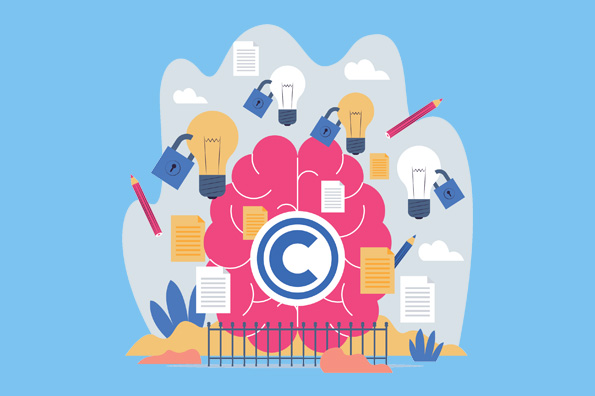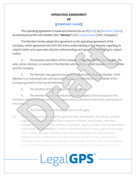7 min read
Mastering the Creative Services Agreement: A Comprehensive Guide
LegalGPS : Jul. 25, 2024
As an entrepreneur, collaborating with creative professionals is an inevitable part of growing your business. Whether you're working with graphic designers, writers, photographers, or any other creative minds, you'll need to have a solid agreement in place. That's where a Creative Services Agreement comes in.
In this comprehensive guide, we'll walk you through the ins and outs of crafting a reliable Creative Services Agreement. We'll also cover the key components, step-by-step process, and pitfalls to avoid. By the end, you'll have the knowledge you need to protect your business effectively during creative collaborations. Let's dive in!


Creative Services Agreement
Legal GPS templates are drafted by top startup attorneys and are fully customizable🛠️.
Trusted by 1000+ businesses to close secure deals.
A Brief Introduction to Creative Services Agreements
A Creative Services Agreement is a legally binding document that lays out the terms of the services provided by a creative professional to a client. It's like a roadmap for the relationship and establishes a clear understanding between both parties. This kind of agreement usually covers the project scope, timeline, payment terms, intellectual property rights, and other relevant information.
Having a Creative Services Agreement is crucial for avoiding disputes and protecting both parties. It also ensures that there's a mutual understanding of what's expected of each party.
Key Components of a Creative Services Agreement
There are a few essential elements you should include in your Creative Services Agreement. Here's a breakdown of what you need to cover:
1. Parties to the Agreement
Start by introducing the parties involved in the agreement. Include the full legal names of both the client and the service provider, and clarify their respective roles.
2. Project Scope
The agreement should outline the services to be provided by the creative professional clearly. Include a detailed description of the project, its objectives, and the deliverables. It's important that both parties have a clear understanding of the work involved, as this will help prevent disagreements down the line.
3. Timeline
Include a project timeline with clear deadlines for each phase or deliverable. This will help ensure that the project stays on track and gives both parties a sense of accountability.
4. Payment Details
Outline the payment terms for the services provided. Specify the total fee, when payments will be made, and whether there will be a deposit or milestone payments involved. You should also include any late payment fees or penalties, if applicable.
5. Confidentiality & Non-Disclosure
This section addresses the need to protect sensitive information that may be shared during the project. Include a confidentiality clause, which states that both parties agree not to disclose any confidential information to third parties. This is particularly important if you're sharing business secrets or working with a freelancer who has access to sensitive information.
6. Intellectual Property Rights
One of the most critical aspects of any creative services agreement is determining who owns the intellectual property rights. This section should clarify whether the creative professional retains the rights to their work or if the client will own it exclusively. Consider including a clause that outlines the specific uses of the work, such as promotional material, social media, or internal documents.
7. Termination
Sometimes, things don't go as planned. That's why it's essential to have a termination clause in your agreement. This section should outline the circumstances under which the agreement can be terminated, whether it's for non-performance, breach of contract, or other reasons. Be sure to include any notice requirements and the process for resolving disputes.
8. Independent Contractor Status
To avoid any confusion or misclassification, confirm that the creative professional is an independent contractor and not an employee. This is important for tax and legal purposes and establishes that the service provider is responsible for their own taxes, insurance, and other obligations.
9. Governing Law & Jurisdiction
Indicate which state's or country's laws will govern the agreement and where any legal disputes will be resolved. This information is vital in the event of a dispute, as it determines how the case will be approached and resolved.


Legal GPS Pro
Protect your business with our complete legal subscription service, designed by top startup attorneys.
- ✅ Complete Legal Toolkit
- ✅ 100+ Editable Contracts
- ✅ Affordable Legal Guidance
- ✅ Custom Legal Status Report
Crafting Your Creative Services Agreement: A Step-by-Step Process
Now that you know what to include in your agreement, let's walk through the step-by-step process of creating the document.
Step 1: Start with a Solid Foundation
Whether you're basing your agreement on a template or starting from scratch, it is essential to have a solid foundational structure. Make sure your document includes clearly labeled sections for Parties Involved, Scope of Work, Payment Terms, Confidentiality & Non-Disclosure, Intellectual Property Rights, Termination, Independent Contractor Status, and Governing Law & Jurisdiction. Have these sections outlined first before filling in the specific details.
|
Example
|
Step 2: Fill Out Parties Involved
Write the full legal names of you, as the client, and the service provider. Indicate your roles -- you're hiring the service provider to complete a specific creative project for your business.
|
Example
|
Step 3: Detail the Scope of Work
In this section, provide a comprehensive, clear outline of the services the creative professional is being hired to provide. Include the specifics of the project, the expected outcome, and clearly defined deliverables. To ensure clarity, try to be as specific as possible.
For instance - instead of saying "Design a logo", you could say "Design a logo in three different variations (color, grayscale, and black and white), and provide in .png and .jpeg formats".
Step 4: Establish the Timeline
Include start and end dates for the project, and deadlines for each phase, if applicable. By breaking the work down into phases and assigning deadlines, the project remains structured and both parties have a roadmap to follow.
|
Example "We will begin work on your project after receiving payment. Once we receive payment, the work will be complete in approximately three weeks. We will provide you with three variations of the design, as well as in-depth insight into how we arrived at our final product." |
Step 5: Define Payment Terms
Next, clearly define the payment terms, which should encompass the total fee for the services, when the payments should be made (upon receipt of invoice, 30 days after invoice issuance, etc.), and whether a deposit is required. Also state the method of payment - check, bank transfer, etc.
|
Example "The total fee for this project is $1,500 USD. Payment will be due upon receipt of invoice; however, we can provide you with a discount of 10% if payment is made within 30 days." |
Step 6: Enforce Confidentiality & Non-Disclosure
Use this section to explain your expectations when it comes to handling sensitive information. If you need to share confidential business information with the service provider, make sure the agreement outlines they may not disclose any of these details to a third party.
For instance, if you’re a technology company who is working with a developer, state that any software source code or other intellectual property will be kept confidential. Also, if you have an idea for a new product and want to see if it’s possible to create it, mention that this information will only be shared with those on your team who need it.
Step 7: Outline Intellectual Property Rights
Here, you'll need to discuss who will own the final product's intellectual property rights. State whether these rights transfer to you once the project is complete, or if the creative professional retains them.
|
Example “All intellectual property rights in the final product, including any software source code or other intellectual property, will be owned by [Company Name]. You will retain all rights to use your own work created during this project.” |
Get Your Creative Services Agreement Template
with a Legal GPS Subscription
Step 8: Define Grounds for Termination
Outline the grounds for terminating the contract. This could be a breach of contract, non-performance, or even included a mutual separation provision, giving both parties the liberty to end the agreement if it's simply not working out.
|
Example “Either party may terminate this Agreement if the other party is in material breach of any obligation under this Agreement and such breach is not cured within thirty (30) days after written notice from the non-breaching party specifying such breach.” |
Step 9: Clarify Independent Contractor Status
To avoid any confusion, explicitly state in the agreement that the creative professional is an independent contractor and not an employee. This disclaimer is important for tax and legal purposes.
|
Example “The parties acknowledge that the independent contractor relationship is one of employer/employee and not an agency or partnership. Neither party will have any fiduciary duty to the other, nor will either party be liable for any act or omission of the other.” |
Step 10: Indicate Governing Law & Jurisdiction
This section indicates which jurisdiction's laws will govern the agreement and where any legal disputes will be resolved. This is important because different states have different laws and interpretations of the law. So if you have an agreement with someone who lives in a different state, the choice of jurisdiction can be important.
|
Example “This Agreement and any dispute arising out of it will be governed by the laws of the State of California. Any legal claim, cause of action or dispute (“Claim”) arising out of or related to this Agreement must be filed within one year after such Claim arose, or be forever barred." |
Step 11: Review and Revise
After drafting your agreement, take the time to review it. Check for any vague terms, and feel free to make changes as necessary to reflect the needs and interests of both parties.
Moreover , it’s important to take the time to review your agreement before you sign it. Make sure that all of the terms are clear and easily understandable by both parties, and make sure that both parties agree with all of the terms.
Step 12: Obtain Signatures
Once you and the creative professional are happy with the terms and conditions outlined in the agreement, it's time to make it official. Both parties should sign and date the document, and each should retain a copy for their records.
Common Pitfalls and How to Avoid Them
Even with the best intentions, mistakes can happen. Here are some common pitfalls to watch out for when crafting your Creative Services Agreement:
-
Vague Language: To avoid misunderstandings, make sure your agreement is clear and concise. Ambiguity can lead to disputes and delays in the project.
-
Incomplete Payment Terms: Be specific about payment terms, fees, and penalties. This ensures both parties understand their financial obligations and helps prevent conflicts over payment.
-
Failing to Address Intellectual Property Rights: Clearly stating who retains the ownership of the creative work is crucial. Neglecting to address this can lead to disputes over rights and usage.
-
Skipping Over Termination & Dispute Resolution: It's essential to outline the termination process and how disputes will be resolved. Having a plan in place can save both time and money if things don't go according to plan.
Crafting a reliable Creative Services Agreement is an essential step in any collaboration involving creative professionals. By taking the time to understand the key components, following the step-by-step process, and avoiding potential pitfalls, you can create a rock-solid document that serves both parties well.
With a well-structured Creative Services Agreement in place, you'll have the peace of mind knowing that your creative collaborations are protected and set up for success. And remember, if you're still in doubt, you can check our professionally-crafted Creative Services Agreement template!
Do I need a business lawyer?
The biggest question now is, "Do I need a business lawyer?” For most businesses and in most cases, you don't need a lawyer to start your business. Instead, many business owners rely on Legal GPS Pro to help with legal issues.
Legal GPS Pro is your All-In-One Legal Toolkit for Businesses. Developed by top startup attorneys, Pro gives you access to 100+ expertly crafted templates including operating agreements, NDAs, and service agreements, and an interactive platform. All designed to protect your company and set it up for lasting success.
Get Legal GPS's Creative Services Agreement Template Now

Legal GPS Pro
Protect your business with our complete legal subscription service, designed by top startup attorneys.
- ✅ Complete Legal Toolkit
- ✅ 100+ Editable Contracts
- ✅ Affordable Legal Guidance
- ✅ Custom Legal Status Report
| Premium Template Single-use Template |
Legal GPS Pro Unlimited Access, Best Value |
|
|
| Get Template | Learn More |
| Trusted by 1000+ businesses | |
